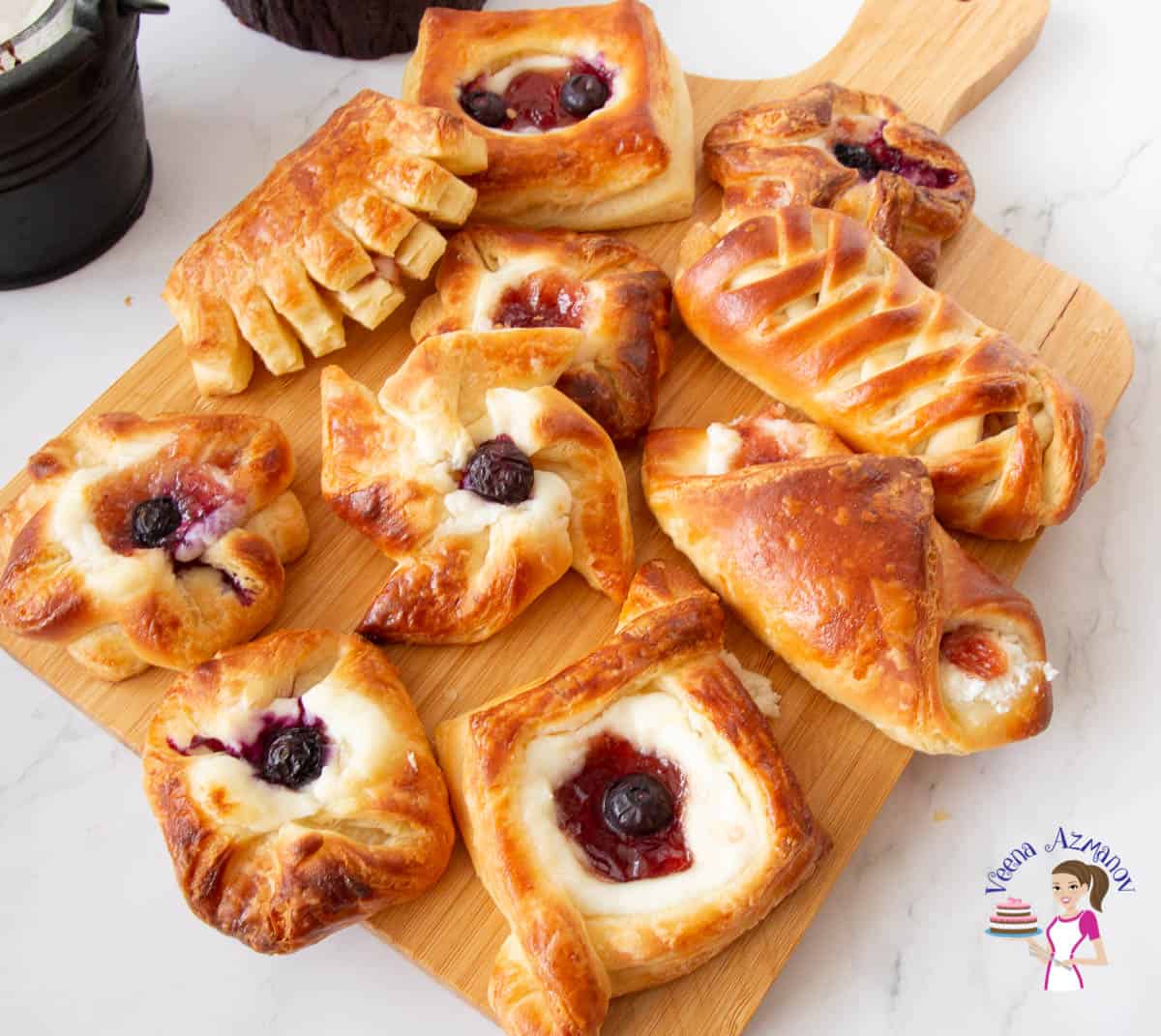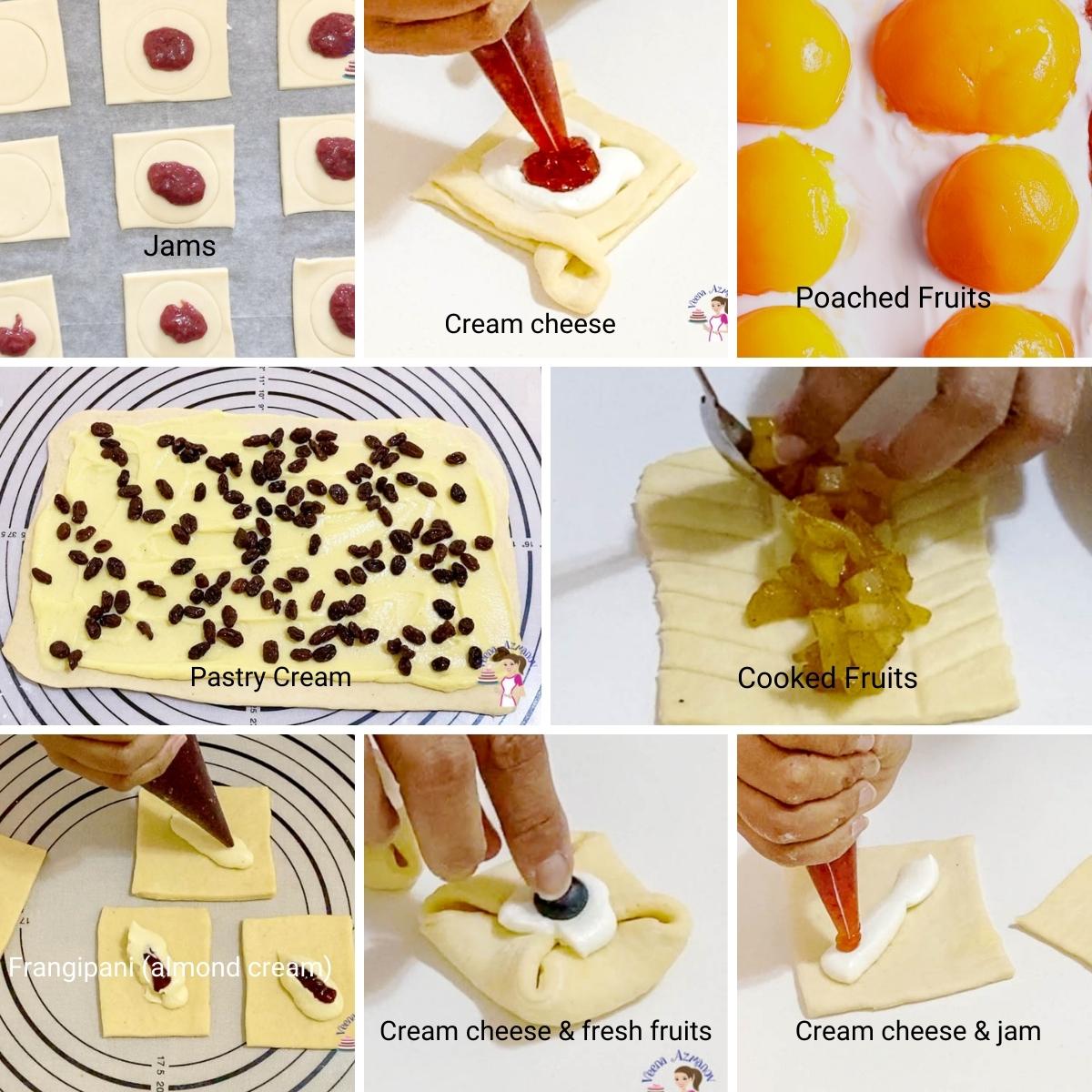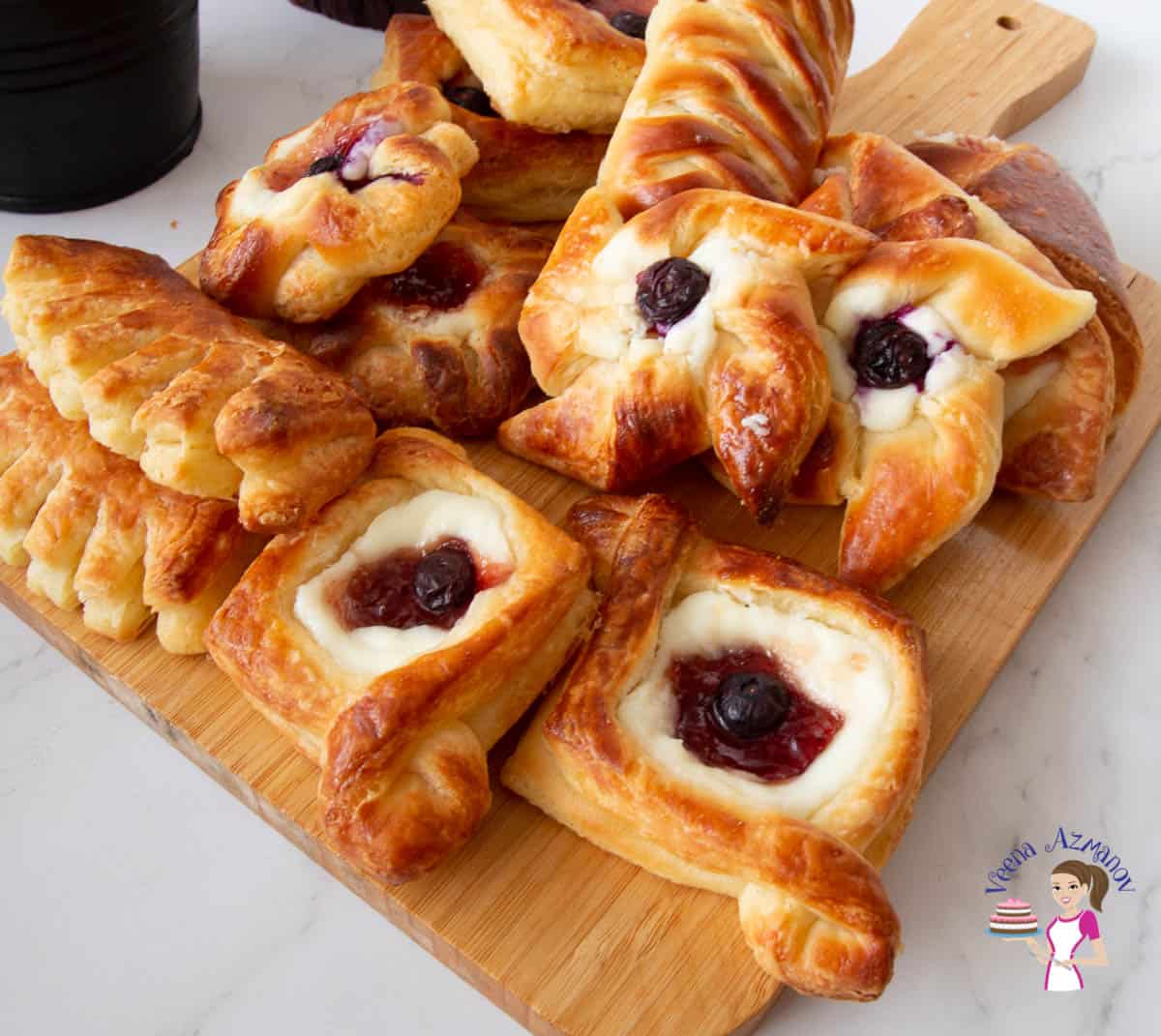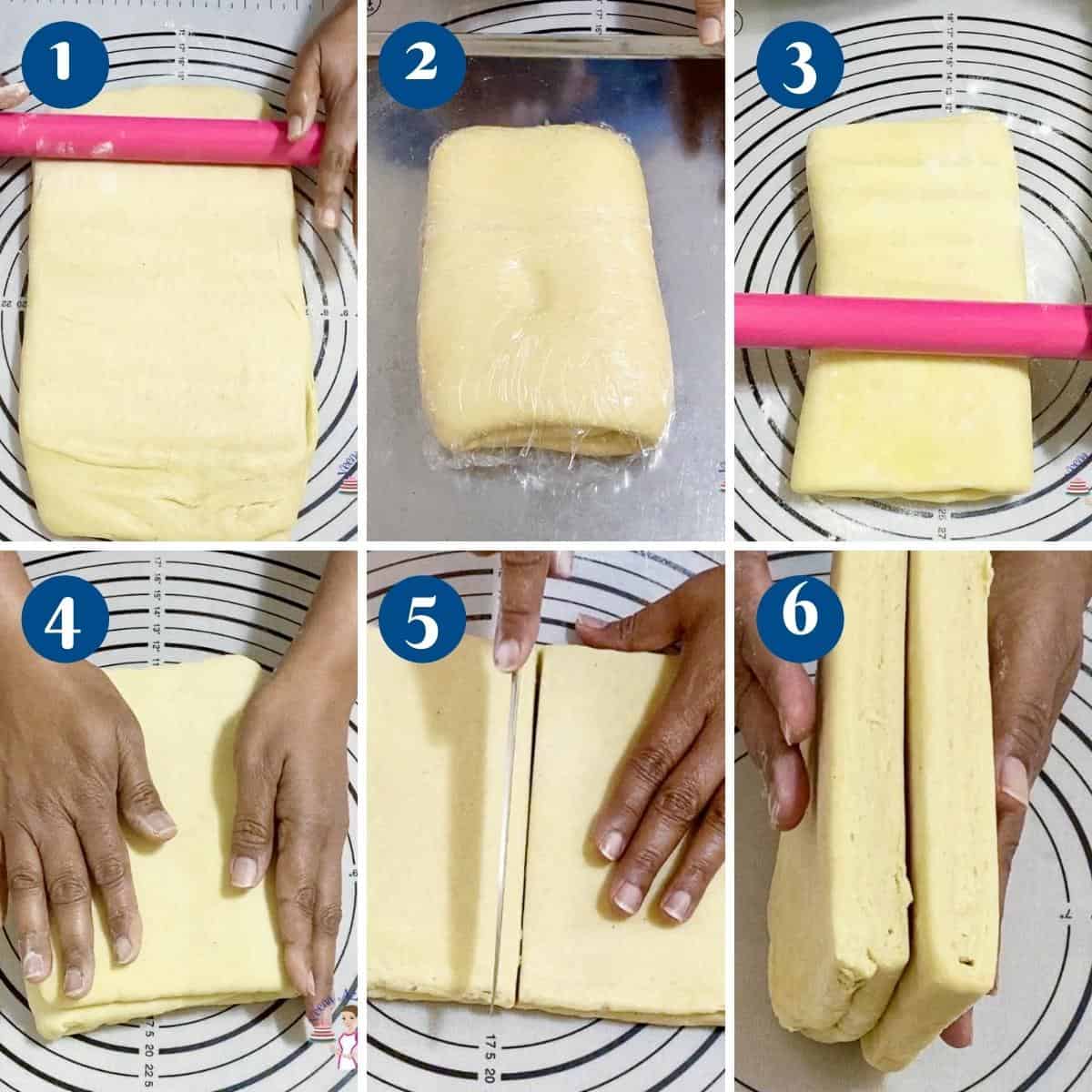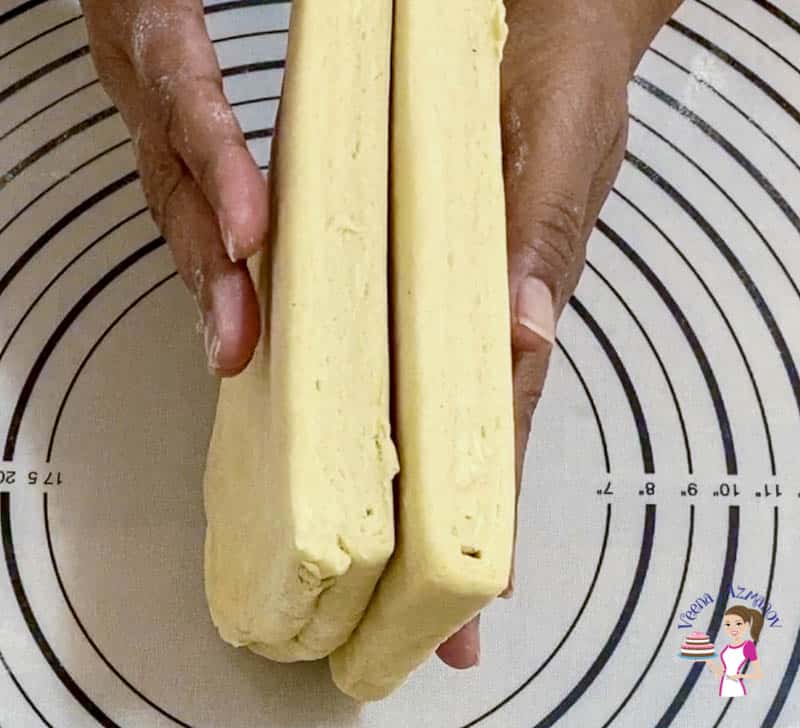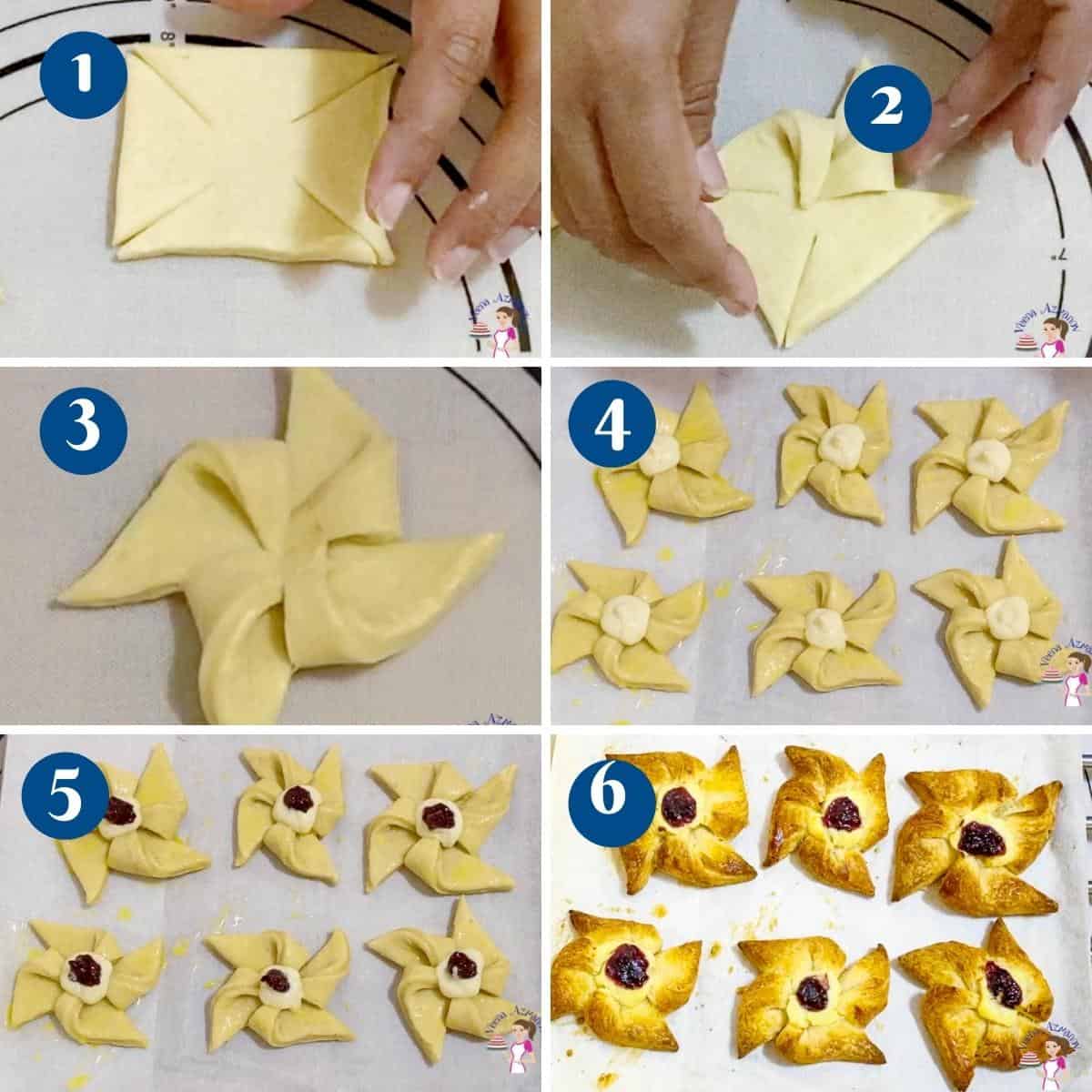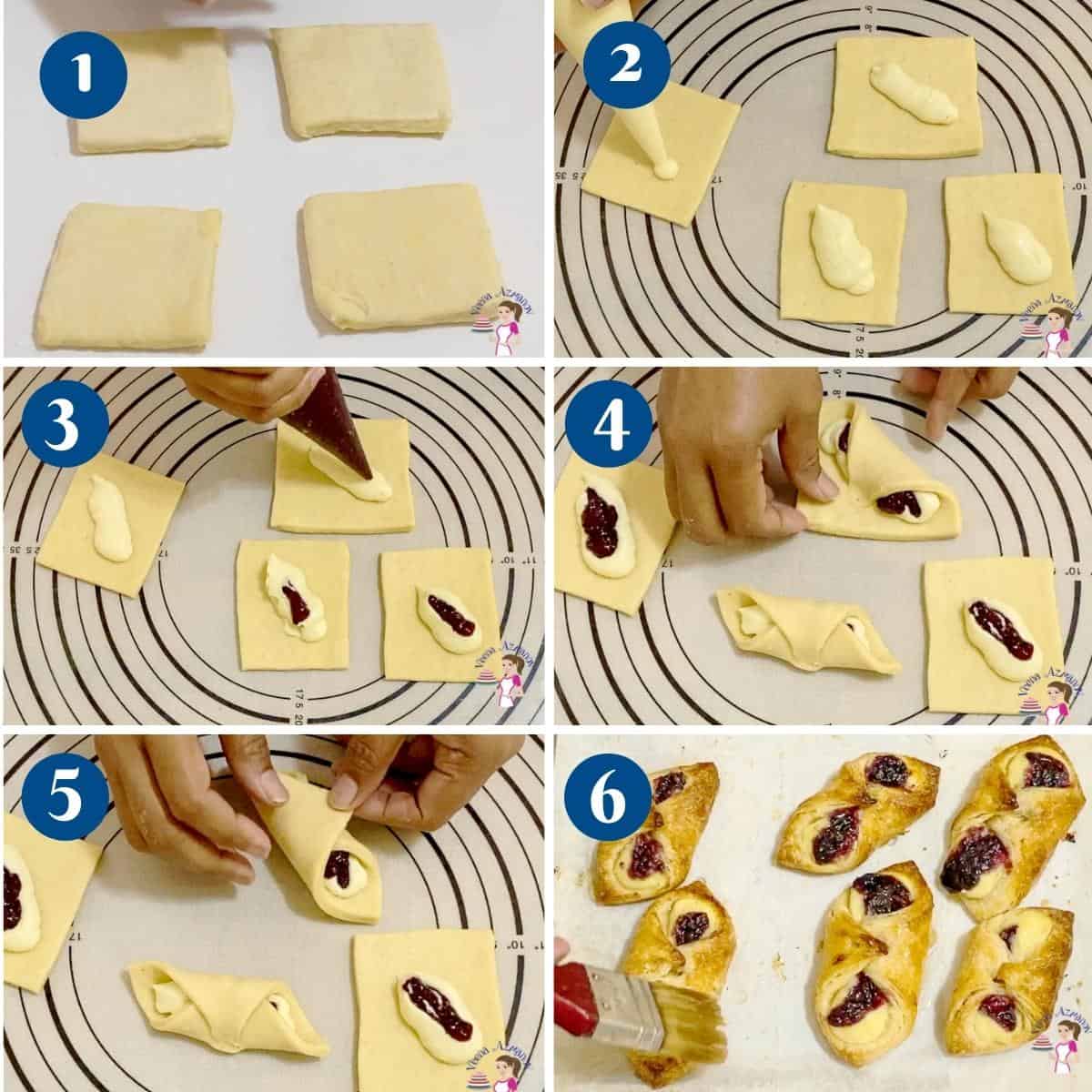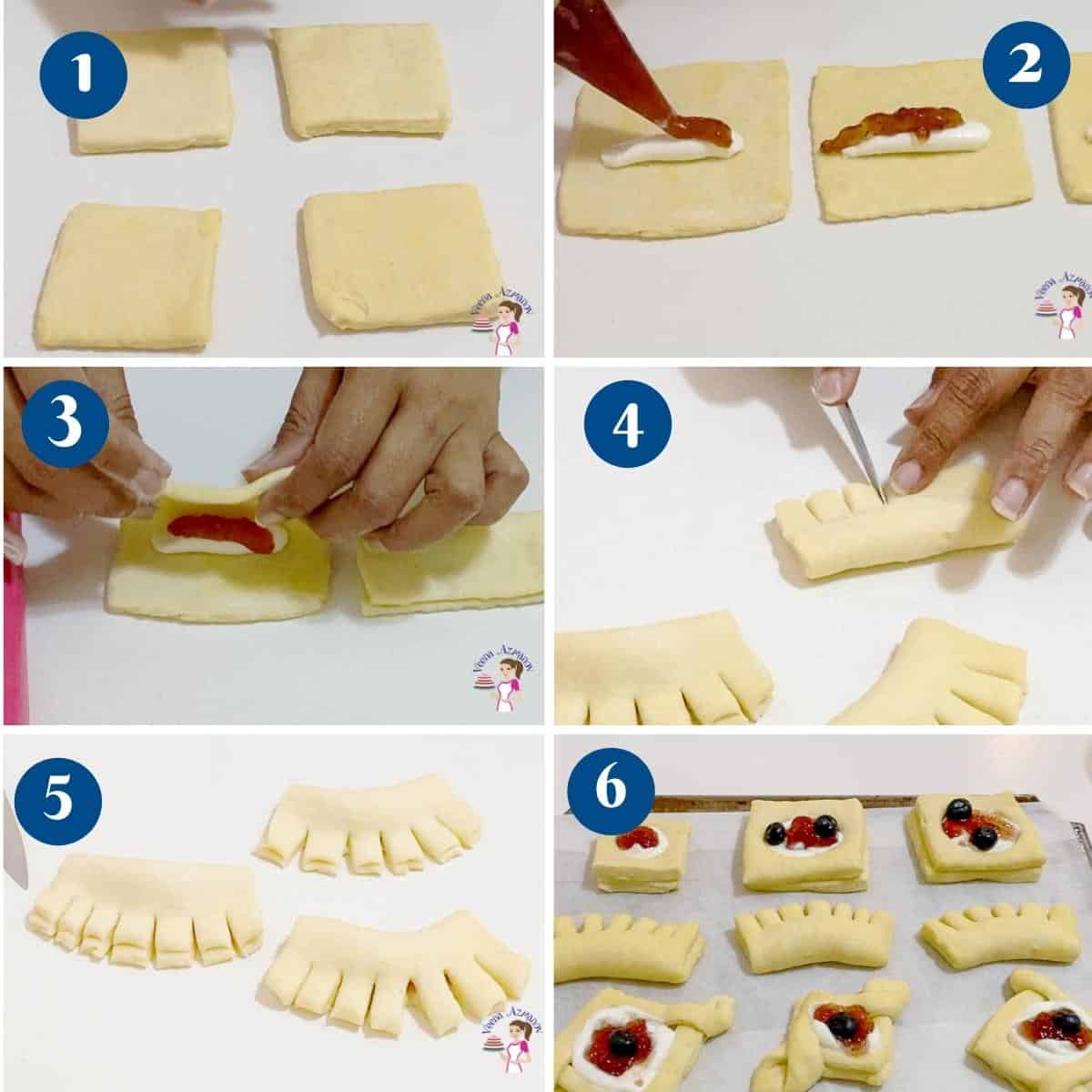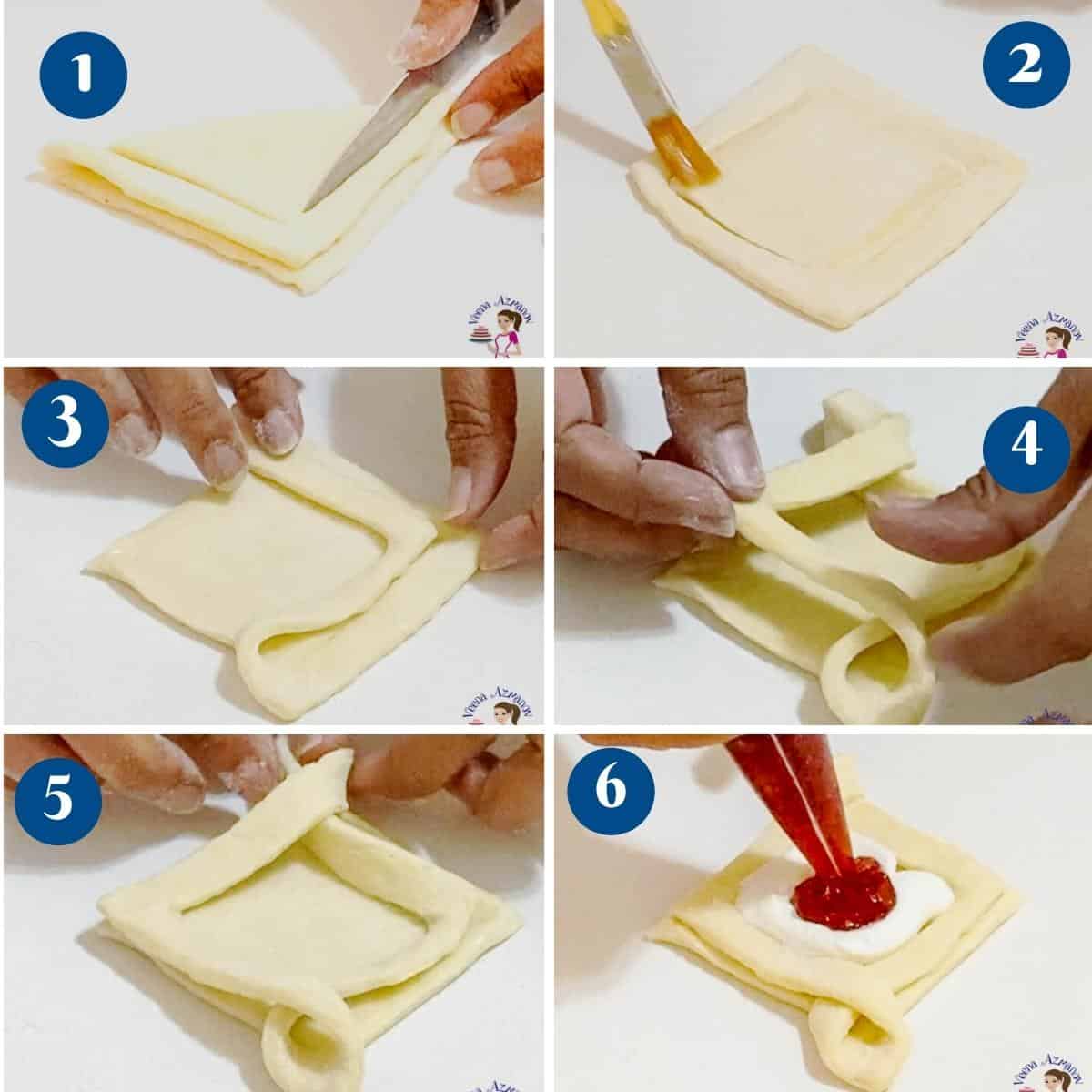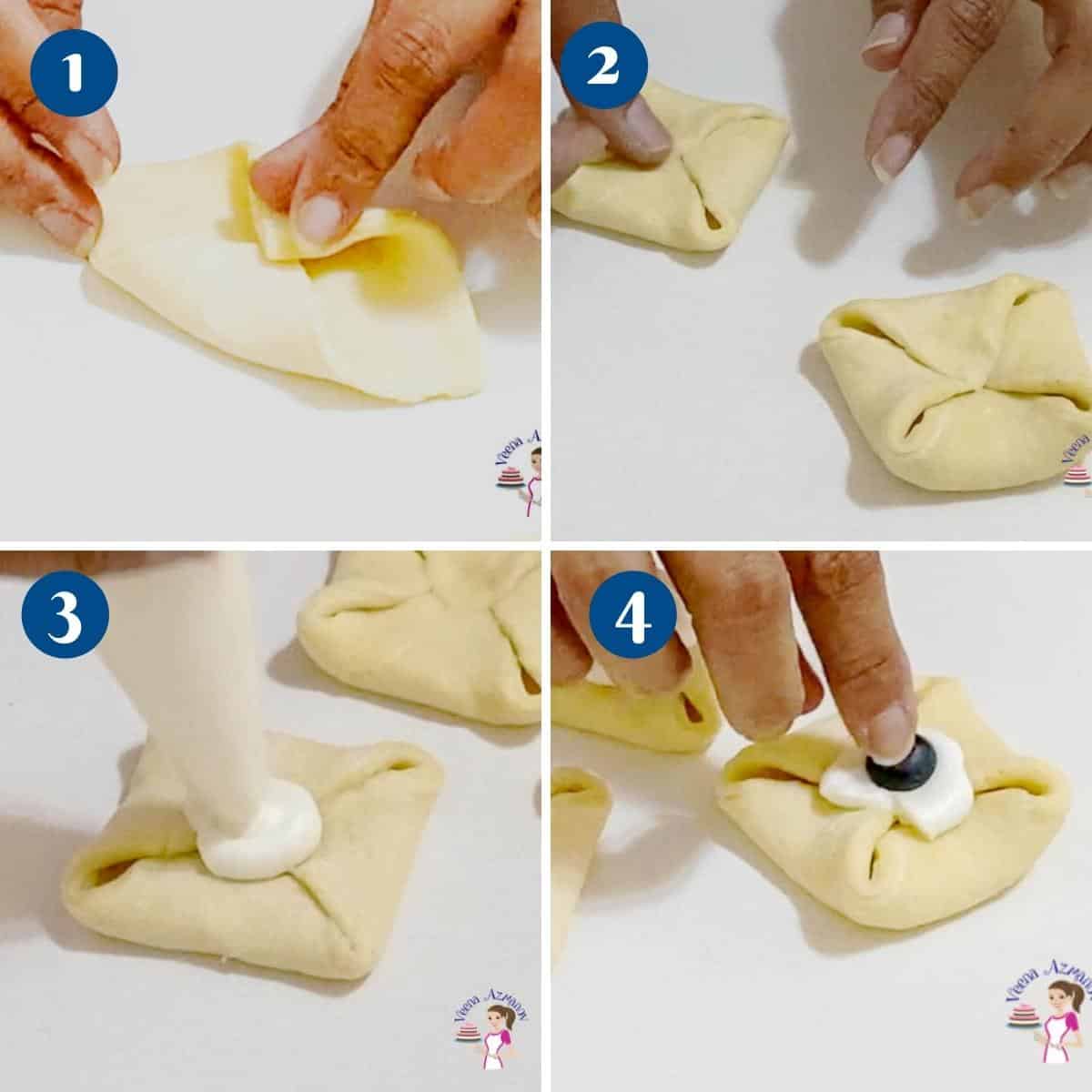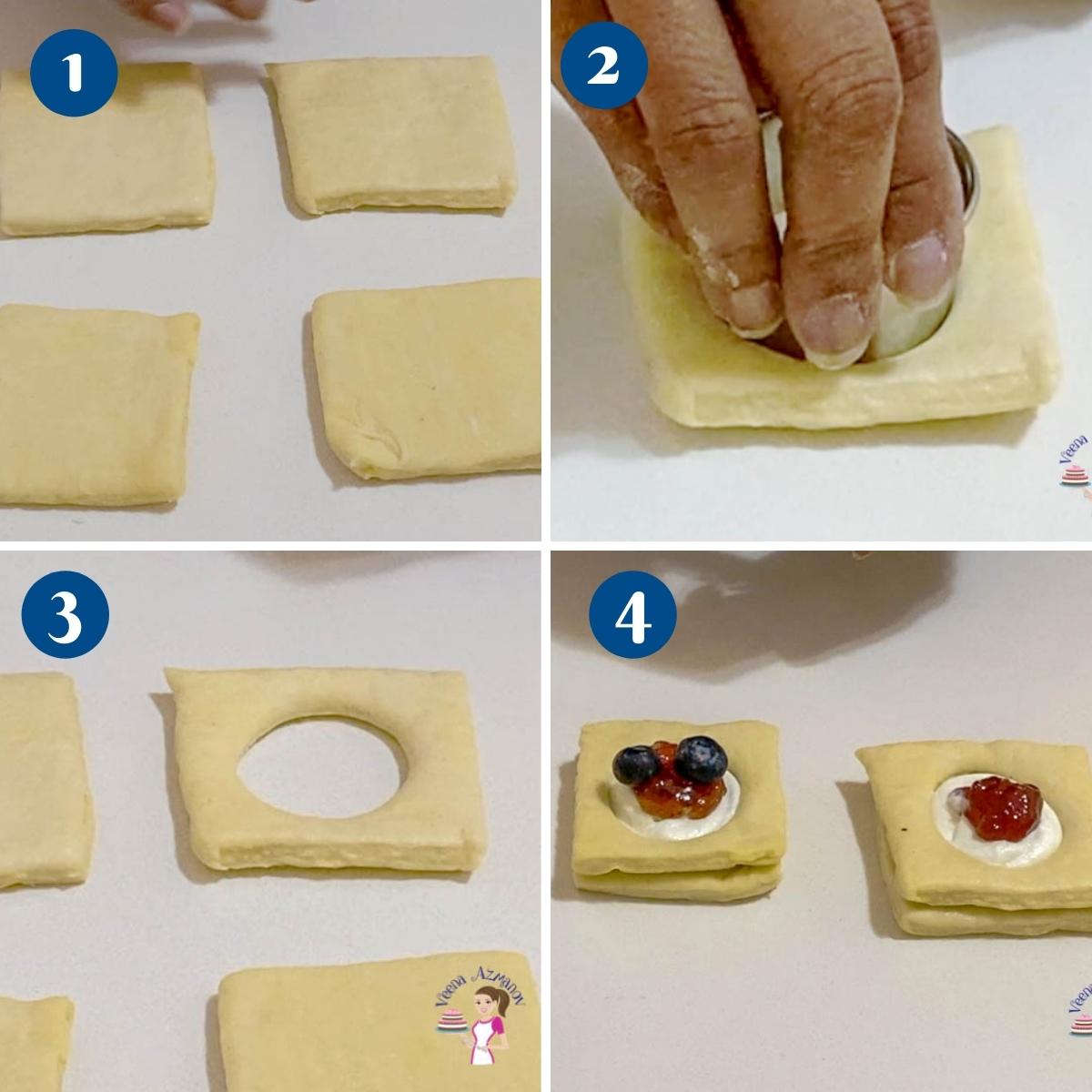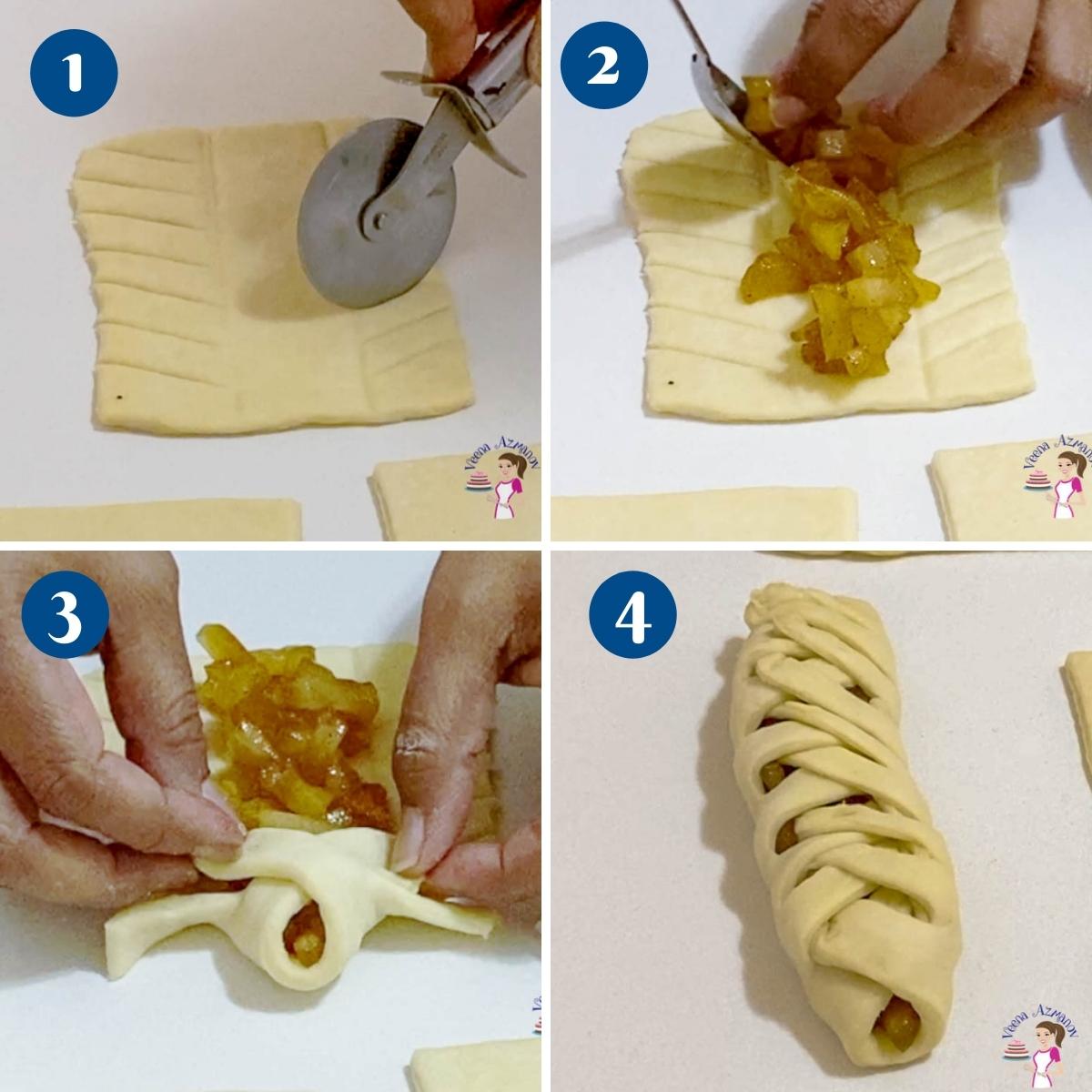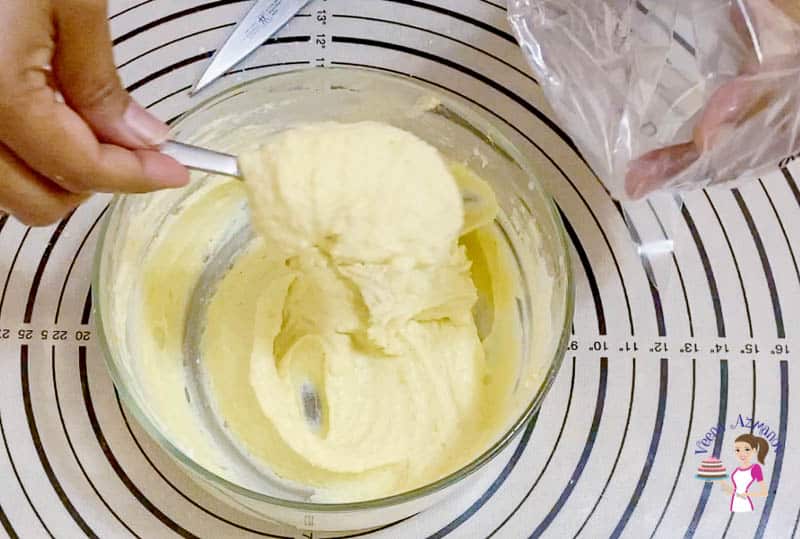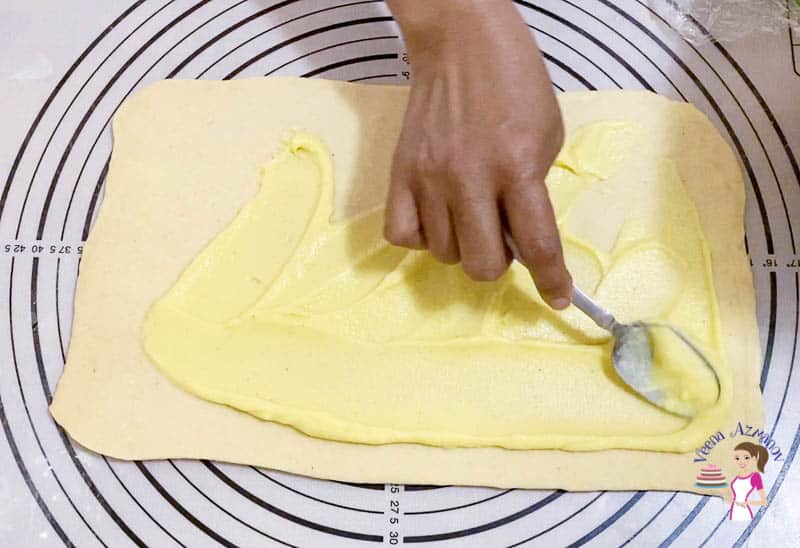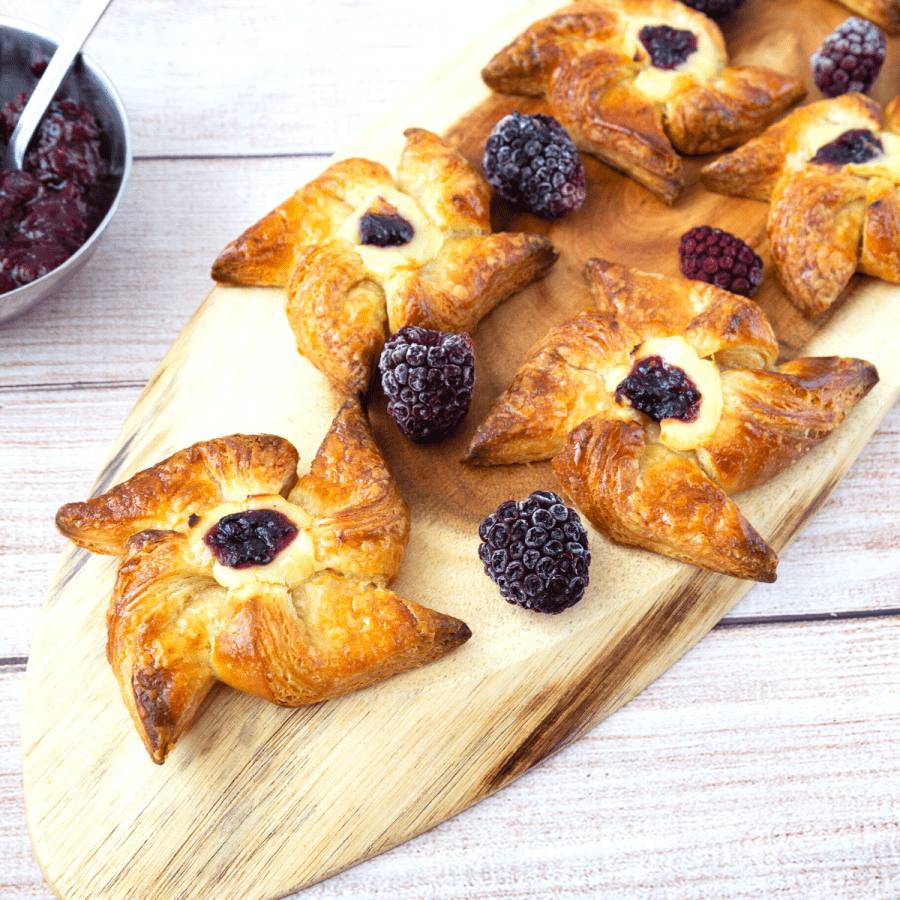Danish pastries are a type of pastries called Viennese (wienerbrød) in Denmark. They are made with a butter lamination similar to puff pastry and croissants. However, this dough also has yeast which results, in more tender but rich flaky, buttery pastries with lots of layers. And, this pastry is a dough that can be used to create many different shapes or varieties of Viennese (pastries) such as these Cream raisins spirals, cinnamon sugar spirals, pinwheels or darts, cheese cylinders, stars, braids, envelops, pockets, combs, squares, horns, etc.
Why make your own Danish?
Firstly, it’s a very forgiving dough that’s easy to knead with a stand mixer or by hand. And, there are two main components to this pastry:
The dough – This is a simple yeast-based dough with eggs, butter, and sugar. It can be soft and sticky to work so don’t skip the chilling times. Butter block – Yes, it is a lot, which we cream with a little flour and then laminate between the dough. And, the purpose of the flour is to help stabilize it. In fact, most professionals often skip the flour, but I recommend you use it. The fillings – These pastries can be filled with almost anything. For example, try cream cheese, almond cream, pastry cream, jams, and fruit fillings as well as fresh fruits. In fact, the options are endless.
Video 1 – Making the dough
Video 2 – Shaping the Pastry
Step-by-step: How to make danish pastry
Dough
Dry ingredients – In the bowl of a stand mixer with the dough hook attachment combine flour and salt. Set aside. You can also use a food processor to make this dough. Pro tip – Salt slows the fermentation process so we add it to the flour rather than directly into the wet mixture. Yeast mixture – In a measuring cup or bowl, combine milk, sugar, yeast, egg, and vanilla.Pro tip – you don’t need to activate the instant variety but, I like to ensure my yeast is good. So, I leave the mixture aside for 3 to 5 minutes, if it foams it’s good to go. Wet to dry – Then, add the yeast to the flour mixture. Combine on medium-high until all flour is incorporated. Knead a minute more.Pro tip – the dough will be soft and sticky but do not add any more flour just yet. Knead – Then, gradually add the room temperature butter, one tablespoon at a time. Then, knead for 3 minutes on medium Alternatively, you can knead by hand for 5 to 7 minutes. Rest – The dough will be soft and slightly sticky. Remove from the mixer, and shape into a ball. Place in an oil bowl and chill for 15 minutes.Pro tip – Unless the dough is too soft and sticky you do not need to add any more flour. Also, if necessary add a few tablespoons only.
Butter blocks
Template – Use a parchment paper to create a template 12 x 6-inches (see video) – set aside. Cream – In the same bowl of the electric mixer bowl (no need to wash), cream the butter and flour just until combined. Transfer to the prepared parchment paper template. Spread evenly with a spatula. Use a rolling pin to guide it inside of the template towards the corners (see video). Divide – Use a ruler to mark them at 6 inches. So, now this will give you two 6 x 6-inch blocks (see video). Pro tip – we need 2 sheets of butter 6 x 6 inches each. You can use a 6-inches square baking pan to make two such blocks. This 12 x 6 method ensures the blocks are even. Pro tip – be gentle with the rolling pin using a spreading motion so the butter doesn’t come out of the corners. Chill in the fridge for 15 minutes. Pro tip – We want the fat to be cold but still be flexible so that when we roll it will spread between the folds. If you chill too long it will break rather than spread. Use a parchment paper to create a template 12 x 6-inches (see video) – set aside.
Laminate the dough
Roll – Transfer the dough to a lightly floured surface. Roll to a long rectangle of 7 x 18-inches. Fold – Open the butter block and divide it into 2 at the mark you created. Now you should have two – 6 x 6-inch blocks. Place one block over the center. Fold one side over. Then, place the second block on top and fold the other side over. Pro tip – Now you should have layers of dough, butter, dough, butter, dough – makes sense? Chill – Wrap the dough, place it on a baking sheet, and into the refrigerator – chill for 15 minutes. Pro tip – if the dough and butter are still cold when you wrap you can continue with the first fold. Also, in warm places, you may need more cooling time.
Folds / turns
Turn the dough – Roll the chilled pastry dough into a rectangle – with the short side facing you. Roll to a rectangle approximately 6 x 12-inches. First fold – Fold the dough lengthways into thirds like a business letter (see video). Wrap in plastic on a baking sheet and place into the fridge to chill for 30 minutes. Second fold – Roll the dough lengthways again with the short side facing you – (see video) to about 6 x 12-inch long again. Fold the dough into thirds again like a business letter (see video). Place in the fridge for 30 minutes if necessary. Third fold – Roll the dough lengthways again with the short side facing you – (see video) to about 6 x 12-inch long again. Fold the dough into thirds again like a business letter (see video). Chill – After the third fold, chill in the fridge for at least two hours or until well chilled. This can be chilled for up to 48 hours.Pro tip– it is very important that the dough be well cold before using; otherwise, the folds will blend ruining all your effort. Divide – Roll the dough into a 6 x 12-inches rectangle. Divide into 2. Place one in the fridge while you work on the second one.Pro tip – you want to work in batches so the dough stays cold at all times. Also, it means you won’t roll too thick.
How to shape Danish pastries
Roll the dough to about 12 x 12-inch square. Trim edges so you have straight sharp edges.Pro tip – I roll to about 13 x 13 so I can trim the edges on all sides and get a 12 x 12-inches square. Trimming will open the folds and give a better rise. You can use the sheet as a whole or cut it into 3 x 3-inch squares, (about 16). Mark at 3-inch from either side as shown in the video.Pro tip – Place the squares in the fridge to keep cold. Work with a few at a time especially if you like in hot and humid conditions.
Pinwheels
Cut the corners of the square three-quarters of the way towards the center. Fold every other point towards the center. Press to seal in the center. Pipe a generous dollop of filling in the center. Pro tip – these tend to open from the center so make sure to press firmly in the center. Place on a baking tray and cover with a clean kitchen cloth. Transfer to the refrigerator to cool
Cylinders or fold over
Pipe a tablespoon of the filling on the square diagonally. Fold two sides over each other diagonally (see video). Place on a baking tray and cover with a clean kitchen cloth. Transfer to the refrigerator to cool. Pro tip – Make sure to press firmly to prevent opening.
Cockscomb
Place filling in the top half of the square. – (see video). Fold the other side over. Use water to stick if necessary. Cut slits so it looks like a comb and when flared it bakes like a cockscomb. Place on a baking tray and cover with a clean kitchen cloth. Transfer to the refrigerator to cool.
Kite, frame, or envelope
Fold the square into a triangle. Make two cuts on the outside edge leaving about 1/4 inch from the edge of the triangle. You just created a frame outside an inner square Open the triangle. Take one side of the frame you created and place it on the other side of the inner square. Then take the other side frame and do the same. The two outer frames you created will overlap creating a kite shape (see the video and progress pictures). Pipe a generous amount of filling in the center. I piped cream cheese and jams, topped with blueberry – (see video). Place on a baking tray and cover with a clean kitchen cloth. Transfer to the refrigerator to cool.
Square
Bring the four corners of the square to meet in the center. Press down to prevent opening. Pipe a generous dollop of filling in the center. (see video). Place on a baking tray and cover with a clean kitchen cloth. Transfer to the refrigerator to cool.
Stars
Fold the square into a triangle and cut an edge about 1/2 inch towards the center. Open the triangle and fold it again on the other side and do the same. So now you have cut edges on all four sides of the square Bring the four corners toward the center. Press down so it won’t open. Pipe a generous dollop of filling in the center – (see video). Place on a baking tray and cover with a clean kitchen cloth. Transfer to the refrigerator to cool.
Fruit puffs or Apricot puffs
Use two 3-squares the same size. Using a 1 1/2-inch cookie cutter, cut a disc from the center out of one of the squares. Place the hollowed center square over the first square using water to stick them together. Pipe a generous dollop of filling in the center. (see video). Place on a baking tray and cover with a clean kitchen cloth. Transfer to the refrigerator to cool.
Braid
Using a utility knife or pizza wheel, cut slanting strips along both sides of the pastry. Leaving the center empty. Pipe a generous amount of filling in the center. I used apple filling (see video). Braid the pastry by crossing the strips over the filling overlapping each other (see video). Place on a baking tray and cover with a clean kitchen cloth. Transfer to the refrigerator to cool.
Baking the Danish
Once you’ve created the pastry shapes and filed them with your choice of filling. Let them proof for 45 minutes. Preheat the oven to 375°F/ 190°C / Gas Mark 5. Brush the pastry with a beaten egg. Bake in the hot oven for 15 to 20 minutes until rich golden brown. Cool on the tray for 10 minutes. Then, brush them with the prepared apricot glaze. (below) These pastries are best enjoyed on the day they are baked. But, they also freeze well.
Danish pastry fillings
Cream cheese spread
Combine all ingredients in a bowl. Keep in the fridge until ready to use.
Pastry Cream
In a heavy bottom saucepan, add the egg yolks, sugar, flour, and vanilla extract. Stir to combine until smooth. Gradually add the milk and cream stirring with a whisk to prevent lumps. Then, place on medium heat – cook stirring continuously until thick and coats the back of a wooden spoon. Strain through a sieve or mesh to remove any curdled eggs.Pro tip – You do want to ensure this pastry cream is thicker than a pouring consistency – so it will be spreading consistency when cooled. (See image below) Cover with plastic wrap making sure the plastic touches the surface of the pastry cream to prevent skin from forming. Chill in the fridge for 4 to 6 hours.Pro tip – pastry cream must be made in advance and cooled thoroughly otherwise it will warm the dough.
Frangipani almond filling
Combine all ingredients in a bowl. Keep in the refrigerator until ready to use.
Apricot glaze
In a saucepan, heat the apricot jam and water on low heat until dissolved. Strain through a sieve – set aside until ready to use. If necessary, warm in the microwave for 10 seconds before using it.
Danish Pastry – Cream Cheese Cylinders Danish Pastry Pinwheels Raisin Danish Pastry – Pain Au Raisin Types of Pastry Choux Pastry Recipe
Frequently asked questions
Cream Puffs – Cheesecake Cream Puffs, Tiramisu Cream Puffs Classic Puff Pastry from Scratch – Pate Feuillettee Blackberry Braided Puff Pastry, Strawberry Braided Pastry, Braided Apple Puff Pastry
Did you LIKE this recipe? Save it for later. You can find my recipes on Pinterest. Follow me on Facebook, Twitter, and Instagram.Subscribe, and I’ll send you new recipes right to your inbox. Thank you for sharing - Save for later







